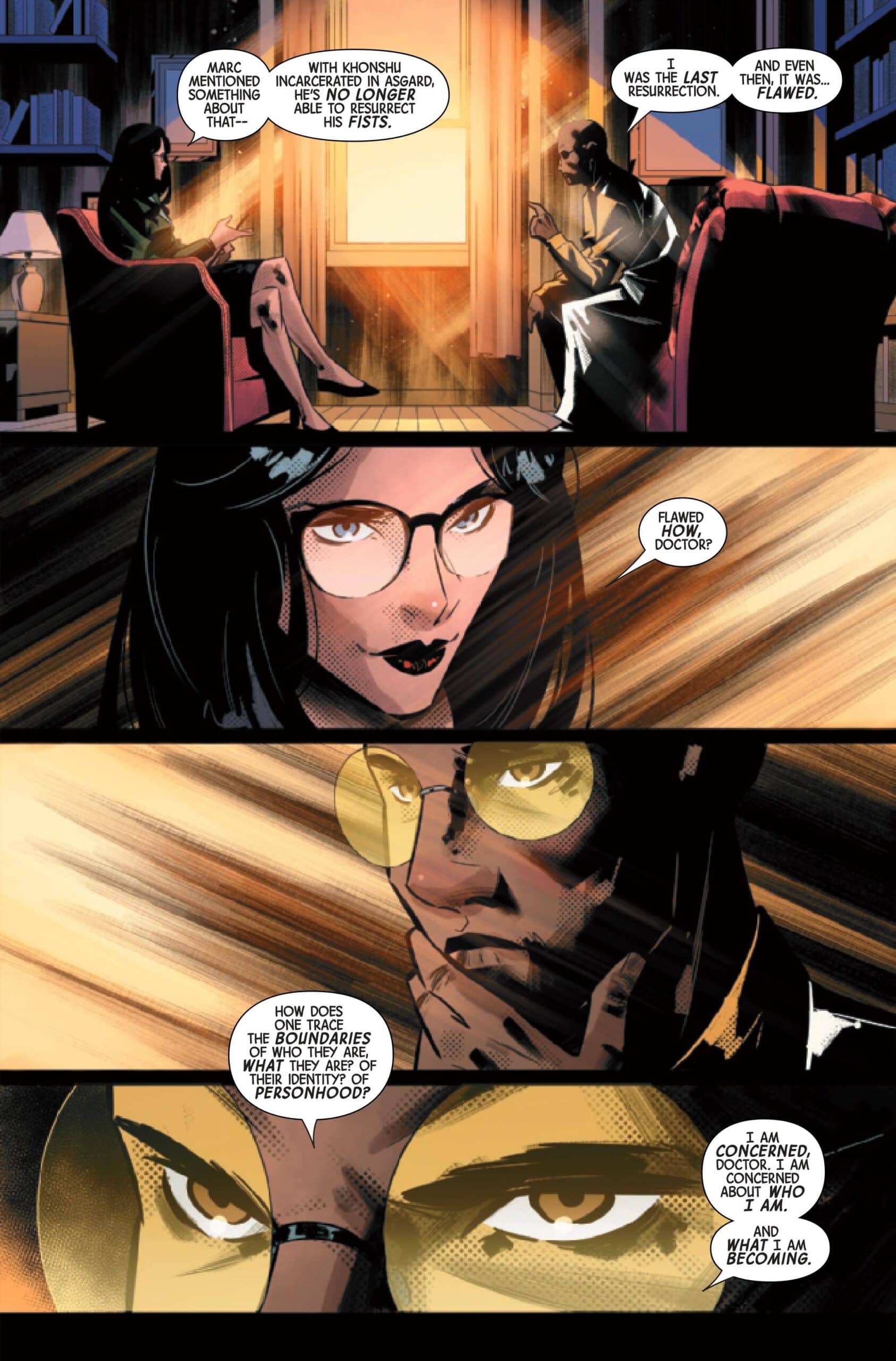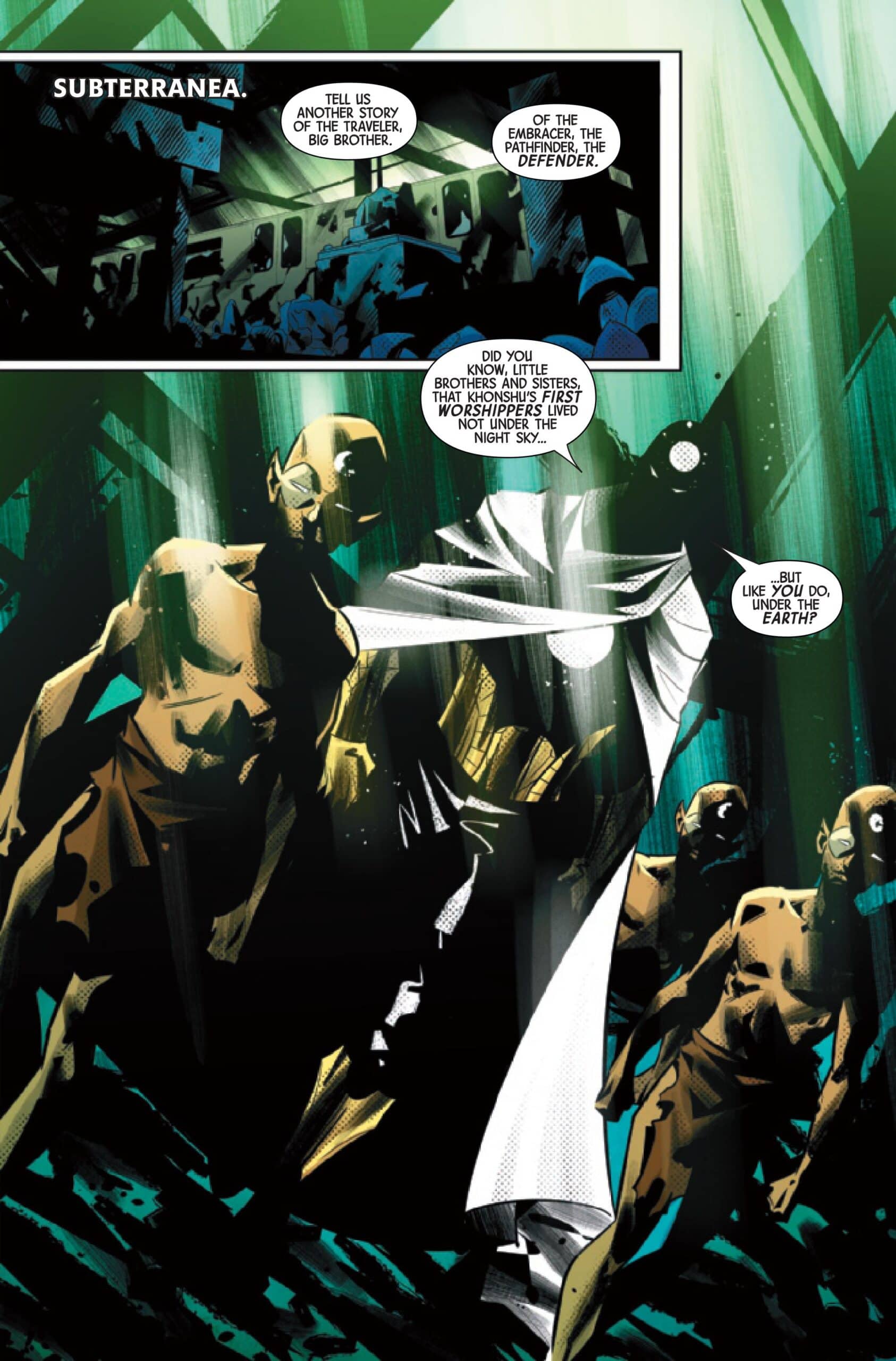Moon Knight #26

Recap
While Moon Knight is dealing with the apocalyptic events of MOON KNIGHT #25, what of Hunter’s Moon? Khonshu’s faithful Fist leads new converts to war, but how exactly was his most recent resurrection flawed, and does this new weakness spell doom for Dr. Badr? PLUS: A bonus page written by Jonathan Hickman—WHO ARE THE G.O.D.S.?
Review
Moon Knight #26 – written by Jed MacKay with art from Frederico Sabbatini, colors by Rachelle Rosenberg, and letters from VC’s Travis Lanham – changes hands to focus on the other Fist of Khonshu, Hunter’s Moon. Badr previously served as a perfect example of an avatar of the moon god, but once Marc Spector imprisoned Khonshu, the boons granted started to dry up. Badr received the last resurrection for a Fist in issue #19 and confirmed the flawed process.

Hunter’s Moon is now trying to accept his new standard and what it means to a flawed avatar like Marc. This leads him to a therapy session with Dr. Sterman, the therapist working with Marc to reconcile his multiple personalities and behaviors during the Age of Khonshu story. Their discussion is intercut with Badr’s recruitment of the Moloids in preparation to battle Black Spectre, the current big bad of the book. The avatar’s sales pitch leads to an attack from a D-list Iron Man villain, Vibro, and the revelation of just how broken the powers of Khonshu’s Fist have become.
MacKay’s script for the issue makes excellent use of the shift in protagonist, echoing the structure of previous entries into the run while further developing a voice for Badr. This gives the feeling of cohesion to the book’s structure as it pivots from one Fist to another while still feeling like a unique look into the mind of Badr. The mix of new tweaks to existing lore with established elements of the Marvel universe and the use of D-list villains lock the familiar in the script into place. It’s an excellent deployment of expectations to ground a new perspective in the familiar.
The scripting also showcases what is being added to the existing Moon Knight lore, creating exciting parallels for the two Fists of Khonshu that are all but eroding by the end of the issue. It makes for a fascinating premise that Marc is no longer alone in the world, now sharing a similar condition that he can help through. MacKay uses a compelling, relatively self-contained story to flesh out the world and create a fascinating new dynamic that may drive or derail the next stretch of the run.

The sense of familiarity partly comes thanks to Sabbatini providing art and Rosenberg coloring the issue. The two bring an expected aesthetic to the story while giving something new in the same swing. Here, Hunter’s Moon’s gold fixtures and channeling of previous Moon Knights expand the look of Sabbatimi’s art, giving a regal, mythologized aura to the linework. It clashes with the setting of the underground tunnels, like bringing the gods down to the lowest pits of hell, making for a rich series of compositions. The action feels just as dynamic as previous issues, but the sacraments of Hunter’s Moon give the sense of righteous fury.
Rosenberg’s coloring matches this, infusing golds and yellows to stand against the usual ethereal blues and greens that have been the staple of the book’s palette. This range of hues goes from regal to sickly and everywhere in between, channeling the underlying tension in Badr to heighten the emotion. They’re most prevalent in the fight between Hunter’s Moon and Vibro, used to showcase the villain’s powers and the avatar’s sacraments. The harsh yellow and shining gold break to a concentrated use of the blue that usually accompanies the Fists’ costumes. The hues channel an abundance of spiritual energy that feels like an eruption and reinforces the distorted nature of Khonshu’s gifts.
The other aspect of the art and coloring played up in the issue is the emotional storytelling, as Badr opens up to Dr. Sterman. The quieter moments of a therapy session make for a fascinating character study as Badr tests the water of his new development as a Fist. Sabbatini uses a series of medium and close-up angles for the discussions, as Badr and Dr. Sterman are both playing it close to the chest.

Inklings of emotions leak out in the beats, and Sabbatini controls the expressions and linework strongly until the swell of emotion is needed. Rosenberg’s coloring gives a radiant hue to the discussion, capturing peeking light beams that help to hide expressions. On the other side of the conversation, the shining lights illuminate a path forward for Hunter’s Moon. In the end, more of Badr’s expression is revealed, and while not everything is solved, the coloring indicates a step in the right direction. It shows a level of skill that reminds readers why the book is one of Marvel’s strongest.
Final Thoughts
Moon Knight #26 is a gripping look at Hunter’s Moon’s handling of his incomplete resurrection. MacKay uses that as an opportunity to take the established tropes of his run and transpose them to a new character as a cipher into the character of Badr. Sabbatini’s art builds on the divergence of perspective to showcase action that brings the holy avatar into the dirt of the earth. Compounded by a new stream of colors, basking in the sickly yellows of the underground and the exalted golds of Hunter’s Moon costume. The art and coloring use these to unearth the emotion buried underneath logic and belief and establish a strong path forward for the rest of MacKay’s run.
Moon Knight #26: A freight train running through the middle of my head
- Writing - 10/1010/10
- Storyline - 10/1010/10
- Art - 10/1010/10
- Color - 10/1010/10
- Cover Art - 10/1010/10





